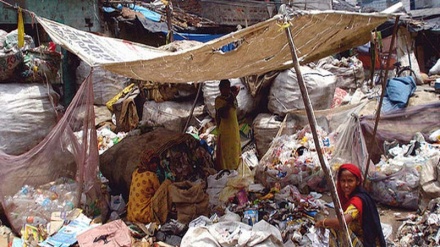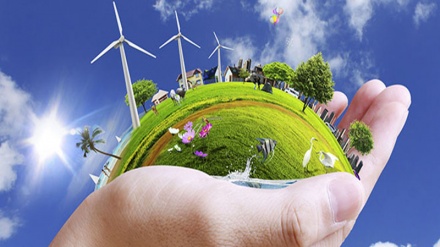We only have one planet to live on (5)
Welcome to the 5th weekly episode of the series ‘We Only Have One Planet to Live On’. Today, we study the shortage of water in the world.
Water is a unique divine blessing. It is a source of existence, and life without water is impossible. The vital importance of water as a source of existence has been emphasized by the divine religions, and religious teachings have called for savings in consumption of water.
However, in the contemporary era, man has contaminated and wasted water, leading to the shortage of water across the globe. The International Water Management Institute has verified this fact, and has pointed out that the root cause of shortage of water across the world is human interferences. The contemporary man, upon contamination and wastage of water, has spawned a global crisis, whose consequences are not restricted to a particular country. The level of underground water sources lowers on a daily basis and water reserves are consumed with a faster pace, without being replaced.
In accordance to forecasts; any country, whose average accessible water stands at less than 1700 cubic meters, is at an alarming state. If this volume of water would stand at less than a thousand cubic meters per person per annum, the given country faces shortage of water. With due regard to this benchmark; United Nations, in the year 1990, studied the state of accessible water in countries round the world, discovering that 28 countries, with an overall population of 335 million people, suffered from shortage of water. In accordance to existing evidences, in the year 2025, a total of 46 to 50 countries will suffer from shortage of water.
For this reason, the Global Nature Fund, in a report released in the year 2006, urged all world countries to lower their rate of consumption of water. This report verified that even rich countries across the world are exposed to shortage of water. For instance, there is shortage of water in the Australian city, Sydney, and city of Boston in the US. This report also points out the massive wastage of water sources in macro cities such as London due to leakage of water from water pipelines.
Hence, the Global Nature Fund has urged developed states to reconstruct their water supply networks and to prevent the contamination of water, turning into role models for other countries. Moreover, a number of international research institutes and environmental bodies have urged the revision of the model of water consumption in developing countries. The selection of type of irrigation in developing countries, which would maintain the highest efficiency and least wastage of water are some of the parameters which can contribute to revival of water sources.
According to environmentalists, one of the most important factors that fuel the shortage of water is construction of large dams, whose heights stand at more than 15 meters. Up to now, 40,000 such dams have been constructed worldwide, while 45,000 other dams, with heights beyond 15 meters are currently under construction across the globe. Construction of these dams in addition to destruction of villages and homelessness of humans spawns climatic changes. According to statistical figures, eighty million villagers have been driven out of their homes and hearths in the past 50 years due to construction of this type of dams. For instance, the construction of a large dam in Sudan led to homelessness of over 50,000 people, who were engaged in agricultural activities next to the banks of River Nile. Human rights groups accuse major industrial companies of construction of this dam to serve their own interests, and hold those companies accountable for homelessness of these people. Moreover, China’s large dam, which stands at more than a hundred meters tall, has highly contributed to climate changes across the world. Throughout the construction of this dam, valuable forests and farmlands were inundated, while the large volume of water reserved behind this dam dried up rivers. Hence, the expectations from these large dams in the past 50 years are yet to be fulfilled.
The Global Nature Fund, which is the largest and most experienced global environment protection organization, has studied seven projects for transference of water. The largest of these projects is related to transference of water in Spain. In this project, the water reserved behind five dams is guided toward the south within a path that stretches for 300 kilometers. The smallest project in this study is the one for transference of water in Australia, along a path that extends for a 100 kilometers. It was found that no research had been carried out on whether these projects were conducive or not. In Spain, the related project was ineffective due to wastage of water along its path. These circumstances have led to innumerable number of people leaving their homes as the result of environmental disasters. According to reports released by the International Immigration Organization, the compulsory migration of people to other countries due to inappropriate climatic conditions has soared on a daily basis. Furthermore, according to the International Committee of Red Cross, roughly 25 million people have left their homes and hearths due to environmental disasters, worldwide.
The UN Chief, Ban Ki Moon, in a keynote speech, pointed out that the economic losses, resulting from the occurrence of natural disasters currently exceeds $300 billion per year, and is expected to significantly raise in the future.
According to UN chief, currently 40% of the global population lives in regions which are faced with intense shortage of water. Moreover, based on forecasts, up until the year 2050, roughly one billion people will be driven out of their homes due to climatic changes.
Meanwhile, how can we counter this major problem and reach a logical solution? Experts present a number of approaches to this end.
Firstly, the governments should change their view toward water as a never-ending and accessible source. Upon the improvement of efficiency of usage of water sources, and encouragement for more effective usage of these sources, the restriction of water sources can be relatively lowered.
In addition to pursuance of this goal, countries should not make unilateral decisions on joint water sources.
The governments should also maintain trans-regional outlooks, and should reinforce their regional cooperation in regard to water sources.
MR/ME


